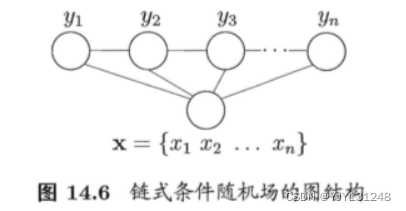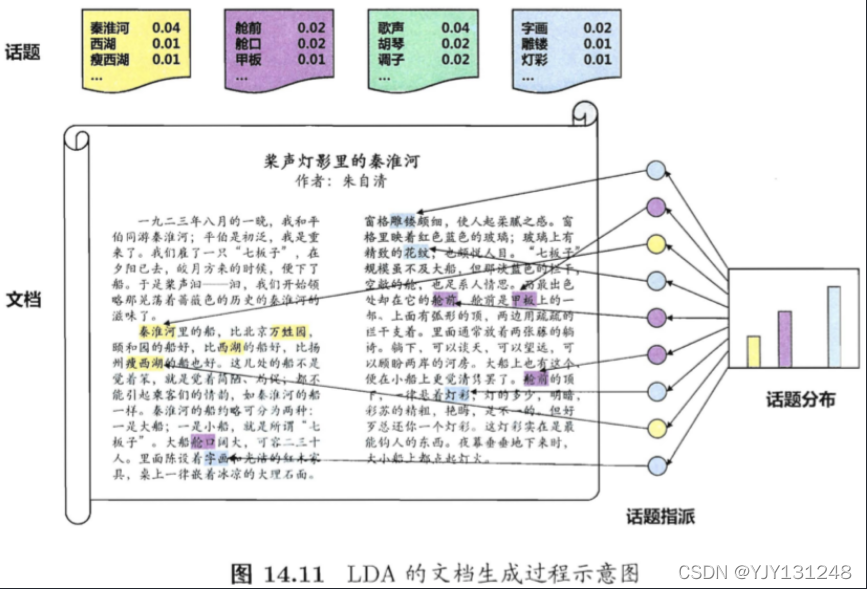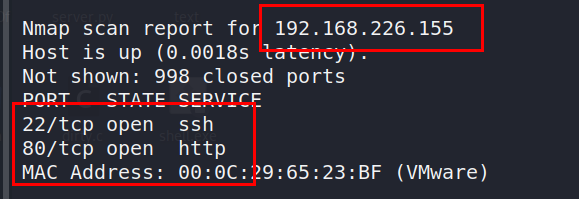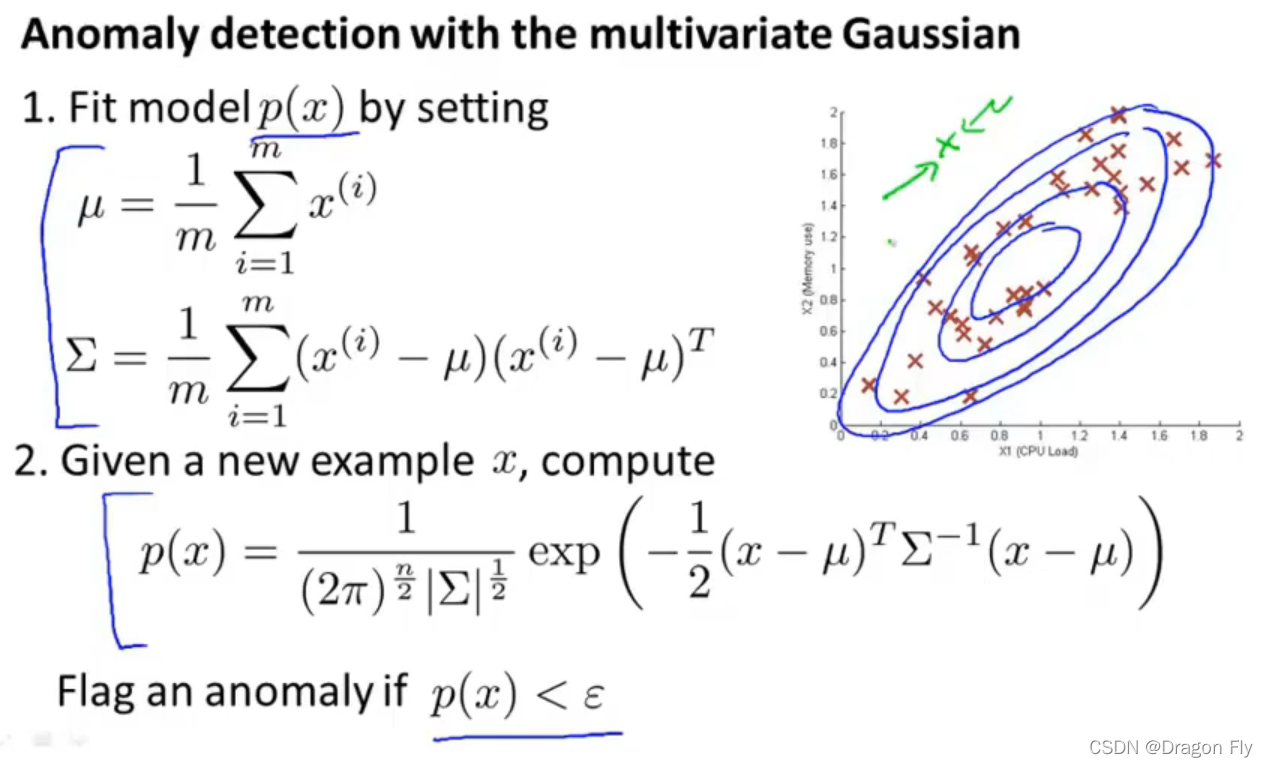当前位置:网站首页>Machine learning (Zhou Zhihua) Chapter 14 probability graph model
Machine learning (Zhou Zhihua) Chapter 14 probability graph model
2022-04-23 02:37:00 【YJY131248】
About teacher Zhou Zhihua 《 machine learning 》 The study notes of this book
Record the learning process
This blog record Chapter14
List of articles
1 hidden Markov model
Probability graph model (probabilistic graphical model): A probabilistic model that uses graphs to express the correlation of variables . The most common is Use a node to represent one or a group of random variables , Between nodes Edges represent the probability correlation between variables , namely Variable diagram . The probability graph model can be roughly classified as :
- Directed acyclic graph ( Directed graph model or Bayesian network )
- Undirected graph ( Undirected graph model or Markov Network )
hidden Markov model (HMM): It's the simplest dynamic Bayesian network , It's a famous digraph model . It is mainly used in time series data modeling . There are two kinds of variables in hidden Markov model :
- State variables ( Hidden variables ): It means the first one i i i System status at any time { y 1 , y 2 , ⋯ , y n } \{y_1,y_2,\cdots,y_n\} { y1,y2,⋯,yn}, It's usually hidden 、 Unobservable .
- Observation variables : { x 1 , x 2 , ⋯ , x n } \{x_1,x_2,\cdots, x_n\} { x1,x2,⋯,xn}, It means the first one i i i Observations at the moment .
In hidden Markov model , The system is usually in multiple states { s 1 , s 2 , ⋯ , s N } \{s_1,s_2,\cdots,s_N\} { s1,s2,⋯,sN} Between , So the state variable y i y_i yi The value range of is usually N N N A discrete space with possible values , So the state variable y i y_i yi Value range of Y Y Y Usually there is N N N A discrete space with possible values ( Y ⊂ S Y \subset S Y⊂S). The observed variables can be discrete or continuous . For the convenience of discussion , We assume that its value range X = { o 1 , o 2 , ⋯ , o M } X=\{o_1,o_2,\cdots,o_M\} X={ o1,o2,⋯,oM}.

At any moment , The value of the observed variable x t x_t xt Only by state variables y t y_t yt determine , It has nothing to do with the values of other state variables and observation variables . meanwhile t t t The state of the moment y t y_t yt Only depends on t − 1 t-1 t−1 The state of the moment y t − 1 y_{t-1} yt−1, And the rest n − 2 n-2 n−2 It has nothing to do with two states , That's what's called “ Markov chain ”: The next state of the system is determined only by the current state , Not dependent on any previous state . The joint probability distribution of all variables is defined as :
P ( x 1 , y 1 , ⋯ , x n , y n ) = P ( y 1 ) P ( x 1 ∣ y 1 ) ∏ i = 2 n P ( y i ∣ y i − 1 ) P ( x i ∣ y i ) P(x_1,y_1,\cdots,x_n,y_n)=P(y_1)P(x_1|y_1)\prod_{i=2}^nP(y_i|y_{i-1})P(x_i|y_i) P(x1,y1,⋯,xn,yn)=P(y1)P(x1∣y1)i=2∏nP(yi∣yi−1)P(xi∣yi)
In addition to structural information , To determine a hidden Markov model, we also need the following three sets of parameters :
-
State transition probability :
a i j = P ( y t + 1 = s j ∣ y t = s i ) , 1 ≤ i , j ≤ N a_{ij}=P(y_{t+1}=s_j|y_t=s_i),\ \ \ \ \ 1\le i,j\le N aij=P(yt+1=sj∣yt=si), 1≤i,j≤N -
Output observation probability :
b i j = P ( x t = o j ∣ y t = s i ) b_{ij}=P(x_t=o_j|y_t=s_i) bij=P(xt=oj∣yt=si) -
Initial state probability :
π i = P ( y 1 = s i ) \pi_i=P(y_1=s_i) πi=P(y1=si)
2 Markov random Airport
Markov random Airport (MRF): A typical Markov Network , Is a famous undirected graph model :
- node : A variable or set of variables
- edge : Dependencies between variables
Markov random fields have a set of potential functions (potential functions), It's also called “ factor ”, That is, a nonnegative real function defined on a subset of variables , It is mainly used to define the probability distribution function .
In Markov random fields , For a subset of nodes in the graph , If any two nodes have edge connections , The node subset is called a “ group ”, If you add another node to the group , Can't form a group , It is called a “ Great regiment ”.

In Markov random field , The joint probability distribution among multiple variables can be decomposed into the product of multiple factors based on the clique decomposition , Each factor is related to only one cluster . say concretely , about n n n A variable X = { x 1 , x 2 , ⋯ , x n } X=\{x_1,x_2,\cdots, x_n\} X={
x1,x2,⋯,xn} , The set of all groups is C C C, And regiment Q ∈ C Q\in C Q∈C The corresponding variable set is recorded as X Q X_Q XQ , Then the joint probability P ( X ) P(X) P(X) Defined as
P ( X ) = 1 Z ∏ Q ∈ C ψ ( X Q ) P(X)=\frac{1}{Z}\prod_{Q\in C} \psi(X_Q) P(X)=Z1Q∈C∏ψ(XQ)
How to get... In Markov random field “ Conditional independence ” Well ? Also with the help of Separate The concept of . As shown in the figure below , If from the node set A Node in to B All nodes in must pass through the node set C Node in , Then it is called node set A and B Passive node set C Separate , C be called " Separate sets " (separating set).
Yes, Markov random field , Yes “ Global markov ” (global Markov property): Given the separation set of two variable subsets , Then the two variable subsets are conditionally independent . in other words , In the picture A, B and C The corresponding variable sets are X A , X B , X C X_A,X_B, X_C XA,XB,XC, be X A X_A XA and X B X_B XB In the given X C X_C XC Under the condition of Independence , Write it down as X A ⊥ X B ∣ X C XA\perp XB|X_C XA⊥XB∣XC.

By global Markov property , Two useful inferences can be drawn :
- Local Markov : Given the adjacency of a variable , Then the variable condition is independent of other variables .
- Paired markov sex : Given all the other variables , Two nonadjacent variables are conditionally independent .
Let's look at the potential function in Markov random field , Its effect is Quantitative characterization of variable sets X Q X_Q XQ Correlation of variables in ( Nonnegative function ), And There is a preference for the value of all variables .
To satisfy nonnegativity , Exponential functions are often defined as potential functions :
ψ Q ( X Q ) = e − H Q ( X Q ) \psi_Q(X_Q)=e^{-H_Q(X_Q)} ψQ(XQ)=e−HQ(XQ)
3 Conditional random field
Conditional random field (Conditional Random Field, abbreviation CRF) It's a discriminant undirected graph model , It's a discriminant model . Conditional random fields try to deal with multiple variables in Conditional probability after given Observations Modeling .
Make G = ( V , E ) G=(V,E) G=(V,E) Represents nodes and marked variables y y y Undirected graph with one-to-one correspondence of prime , y v y_v yv Indicates the connection with the node v v v The corresponding tag variable , n ( v ) n(v) n(v) Represents a node v v v Adjacent nodes of , If the figure G G G Each variable of the y v y_v yv All satisfy Markov property , namely
P ( y v ∣ x , y V \ { v } ) = P ( y v ∣ x , y n ( v ) ) P(y_v|x,y_{V\backslash \{v\}})=P(y_v|x,y_{n(v)}) P(yv∣x,yV\{
v})=P(yv∣x,yn(v))
be ( y , x ) (y,x) (y,x) Constitute a conditional random field .

4 Learning and inference
- Variable elimination

- The spread of faith

5 Approximate inference
- MCMC sampling : The key is to construct " The stationary distribution is p p p Markov chain of " To generate samples .
- Variational inference : By using the known simple distribution to approximate the complex distribution to be inferred , And by limiting the type of approximate distribution , Thus, a local optimal 、 But the approximate a posteriori distribution with definite solution .
6 Topic model
Topic model (topic model) It's a family Generative directed graph model , It is mainly used to process discrete data ( Such as text collection ), In information retrieval 、 Natural language processing and other fields are widely used . Implicit Dirichlet distribution model (Latent Dirichlet Allocation, abbreviation LDA) It is a typical representative of topic model .
Basic concepts in topic model :
- word (word): The most basic discrete element
- file (document): Regardless of the order ( The word bag )
- topic of conversation (topic): A series of Related words , And the probability of their occurrence under this probability
Let's assume that the dataset contains a total of K K K A topic and T T T document , The word in the document comes from a containing N N N A dictionary of words . We use it T T T individual N N N Dimension vector w = { w 1 , w 2 , ⋯ , w T } w=\{w_1,w_2,\cdots,w_T\} w={ w1,w2,⋯,wT} Represents a dataset ( Document collection ), K K K individual N N N Dimension vector β k ( k = 1 , 2 , ⋯ , K ) \beta_k\ \ (k=1 ,2,\cdots, K) βk (k=1,2,⋯,K) It means the topic , among w T ∈ R N w_T\in \mathbb R^N wT∈RN Of the n n n Weight w t , n w_{t,n} wt,n Represents a document t t t Middle word n n n The frequency of words , β k ∈ R N \beta_k\in \mathbb R^N βk∈RN Of the n n n Weight β k , n \beta_{k,n} βk,n It means the topic k k k Middle word n n n The frequency of words .
LDA Look at documents and topics from the perspective of a generative model . say concretely ,LDA Think that each document contains multiple topics , You might as well use vectors θ t ∈ R N \theta_t\in \mathbb R^N θt∈RN Represents a document t t t The proportion of each topic included in , θ t , k \theta_{t,k} θt,k Represents a document t t t Topics included in k k k The proportion of , Then through the following steps from the topic " Generate " file t t t:
- According to the parameters α \alpha α The Dirichlet distribution randomly samples a topic distribution θ t \theta_t θt
- Follow the steps below to generate... In the document N N N Word
- according to θ t \theta_t θt Assign topics , Get document t t t Middle word n n n The topic of z t , n z_{t,n} zt,n
- According to the word frequency distribution corresponding to the assigned topic β k \beta_k βk Random sampling generates words

版权声明
本文为[YJY131248]所创,转载请带上原文链接,感谢
https://yzsam.com/2022/04/202204230236363265.html
边栏推荐
- 魔王冷饭||#078 魔王答上海、南京行情;沟通指导;得国和打杀筛选;赚钱的目的;改变别人看法
- day18--栈队列
- Intelligent agricultural management model
- Lighting LED of IAR embedded development stm32f103c8t6
- 全局、独享、局部路由守卫
- 006_ redis_ Sortedset type
- MySQL JDBC编程
- After idea is successfully connected to H2 database, there are no sub files
- JVM运行时数据区(一)
- 每日一题冲刺大厂第十六天 NOIP普及组 三国游戏
猜你喜欢

R language advanced | generalized vector and attribute analysis

Daily question (April 22, 2022) - rotation function

Jupyter for local and remote access to ECS

每日一题冲刺大厂第十六天 NOIP普及组 三国游戏
Rich intelligent auxiliary functions and exposure of Sihao X6 security configuration: it will be pre sold on April 23
![Parental delegation model [understanding]](/img/ba/07e280a2634018e0d6b56c05dd3bc0.png)
Parental delegation model [understanding]

1、 Sequence model

MySQL C language connection

打靶narak

十六、异常检测
随机推荐
Water diversion into chengluo Valley p1514
005_ redis_ Set set
在MySQL Workbench中执行外部的SQL脚本,报错
First day of rhcsa
The second day of learning rhcsa
想用Mac学习sql,主要给自己个充足理由买Mac听听意见
每日一题(2022-04-22)——旋转函数
PHP sorting of interview questions on April 20, 2022
IAR嵌入式開發STM32f103c8t6之點亮LED燈
Renesas electronic MCU RT thread development and Design Competition
数仓建表111111
Consider defining a bean of type 'com netflix. discovery. AbstractDiscoveryClientOptionalArgs‘
Implementation of distributed scenario business operation log (based on redis lightweight)
打靶narak
Rhcsa day 4 operation
Halo open source project learning (I): project launch
类初始化和实例初始化面试题
Execute external SQL script in MySQL workbench and report error
认识进程(多线程_初阶)
010_ StringRedisTemplate
